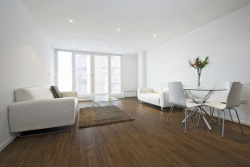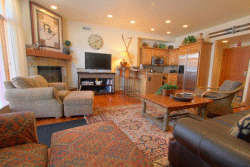Recessed Lighting Fixtures: Downlights, Baffles, Layouts, and More
Recessed lighting fixtures provide nearly invisible lighting for your rooms.
Recessed lighting fixtures are one of the most popular types of lighting. By lighting entire rooms evenly without visual clutter, they have become very well-liked by both interior and lighting designers. However, there are a number of mistakes that can easily be made using recessed lighting. In this article, I will discuss how to make the most of recessed lighting and to avoid the worst of these mistakes.
Advantages of Recessed Lighting
Recessed lighting has a number of significant advantages over other forms of lighting. Overwhelmingly, the advantages of recessed lighting fixtures is that they are subtle.
Contemporary ceiling lighting has increasingly shied away from glare-bomb-causing single light sources and moved toward multiple light sources that spread out the light more evenly. However, in order to do this, you need to add more and more lighting fixtures. If this is done by adding more and more visible lighting fixtures, there are more and more objects within the visible field.

Modern design often eschews objects in favor of geometry.
As a result, a conflict arose between the needs of lighting design (using more lighting sources at recessed lighting spacing) and the needs of interior design (being minimalist). As a compromise, recessed lighting fixtures became an important part of much modern lighting design, providing a détente between lighting and interior designers.
Recessed lighting provides lighting without providing visible lighting fixtures with the exception of the recessed lighting trim. The lights themselves are hidden within the ceiling and they cannot be seen by the eye. Even the glow from the housing can be hidden using baffles, objects that prevent seeing the bulb from anywhere except directly below the housing.
Recessed lighting, therefore, is a great way of providing multiple light sources for a room that doesn’t clutter it up with visible fixtures. This light can easily be evenly spread across the entire space.
Disadvantages of Recessed Lighting
Unfortunately, recessed lighting has a number of disadvantages that, if they are not taken properly into account, can easily lead to serious lighting mistakes that can harm and even ruin a room’s ambience.
Inflexibility
One of the serious difficulties with recessed lighting fixtures is its inflexibility. Unlike portable lighting fixtures, recessed lighting fixtures are stuck in position in your chosen recessed lighting layout. Even pendant and wall lighting fixtures are easier to move than recessed ones. As a result, you will often find yourself arranging your furniture to meet the needs of your lighting rather than arranging your lighting to meet the needs of your furniture.

Recessed lighting is correctly placed only over inflexible areas in this room.
However, recessed lighting fixtures almost always cause problems when used in living rooms and family rooms. In these spaces, people constantly move around sofas, chairs, entertainment areas and so forth, depending on their needs. They will even move them depending on how many guests they are having. Recessed ceiling lighting puts a chill on the flexibility and functionality of living areas.
There are flexible recessed lighting fixtures. These fixtures include reflector bulbs and they can have their direction moved so that they can light different areas without reinstallation. However, these do not solve the difficulty. Because they are reflector bulbs, these lights cast a very strong beam of light, which functions more like a spotlight than light general ambient lighting. Flexible recessed lighting fixtures are fine for accent lighting, but they won’t light your room evenly.
Lighting Quality
The second difficulty with recessed lighting fixtures is the quality of the light itself. In fact, this is a more serious issue than the inflexibility. Recessed ceiling lighting is, by its very nature, downlighting. That is, it strikes all objects with light from directly above.

Downlighting creates shadows under the nose and in the eyesockets and accentuates wrinkles.
This is yet another reason why recessed lighting should usually be avoided in living and family rooms. It doesn’t make any sense to spend time putting on makeup and choosing attractive clothing to wear for a social event, only to have your lighting age you by ten years or more. In general, if an area is going to be used primarily for socialization, recessed lighting should be avoided.
Another place to be cautious of recessed lighting is in the bathroom, particularly at the vanity. If your primary light source when applying makeup or shaving is a recessed light, you’ll be starting the day with a false impression of your appearance, and it may even skew how you apply makeup.
This difficulty can be countered to some extent by adding additional light sources to your room, either wall lights or pendant lights, that will shine light on people’s faces from other angles. This additional light will rid faces of the ugly shadows. It isn’t necessary that these light be as bright as the recessed lights. Their only purpose is to make sure that people’s blemishes are not overly accentuated.
Of course, this brings us back to the original conflict. When adding wall lights and pendant lights, we lose the minimalist style that made recessed lighting so popular in the first place. In the end, we have something of an insoluble dilemma: there will always be trade-offs between minimalism and multiple light sources.
Putting It All Together
Recessed lighting fixtures are one of the most popular styles today:
- They allow for multiple light sources to be used without cluttering the visual field.
- They are inflexible, and best used in spaces with inflexible objects like bathrooms and living rooms.
- They look terrible on people’s faces, accentuating textures and therefore blemishes.
- Their harshness can be offset using wall and pendant lighting.
By keeping the above in mind, you will be better able to make wise decisions about the use of recessed lighting fixtures in your home.
More Recessed Lighting Articles:
Recessed Lighting Layout: Finding the Right Spacing and Locations
Your Recessed Lighting Layout Can Affect Your Overall Lighting Quality.
Recessed Lighting Trim: Improving Appearance and Functionality
A recessed lighting trim changes the appearance of your recessed lighting and provides options for directing your light.
Recessed Lighting Spacing: Finding Just the Right Measurements for Your Room
Recessed lighting spacing requires a few simple calculations based on your manufacturer’s specifications.
Installing Recessed Lighting: Getting Professional-Looking Ceilings
Useful information for installing recessed lighting on your ceilings.
Recessed Light Bulbs: Choosing the Right Bulbs For Your Needs
Recessed light bulbs come in a variety of materials, wattages, angles and colors.
Return from Recessed Lighting Fixtures to Home Lighting Tips